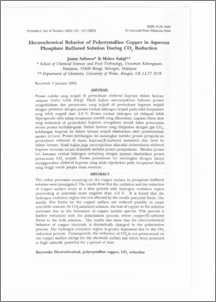Citation
Salimon, Jumat and Kalaji, Maher
(2003)
Electrochemical Behavior of Polycrystalline Copper in Aqueous
Phosphate Buffered Solution During CO2 Reduction.
Pertanika Journal of Science & Technology, 11 (1).
pp. 135-144.
ISSN 0128-7680
Abstract
The redox processes occurring on the copper surface in phosphate buffered
solution were investigated. The results show that the oxidation and the reduction
of copper surface occur in a slow process with hydrogen evolution region
proceeding at potential more negative than -1.0 V. It is found that the
hydrogen evolution region was not affected by the anodic potential limits. The
anodic film forms on the copper surface are reduced possibly in quasireversible
manner. In CO2-saturated solution, the loss of copper to the solution
increases due to the formation of copper soluble species. This process is
further enhanced with the polarization process, where copper(I)-carbonyl
forms to the bulk solution. The results also show that the electrochemical
behavior of copper electrode is dramatically changed by the polarization
process. The hydrogen evolution region is greatly depressed due to the CO2
reduction process. Consequently, the reduction of CO2 is not pronounced on
the copper surface except for the electrode surface has which been polarized
at high cathodic potential for a period of time.
Download File
![[img]](http://psasir.upm.edu.my/style/images/fileicons/application_pdf.png)  Preview |
|
PDF
Electrochemical_Behavior_of_Polycrystalline_Copper_in_Aqueous.pdf
Download (2MB)
|
|
Additional Metadata
Actions (login required)
 |
View Item |

